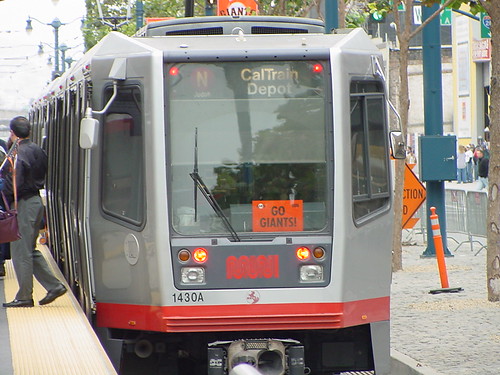
It's almost every single day, there's something wrong with Muni metro. Just today, SF Appeal reported the automatic train control systems was not functioning properly and Muni had to supplement the backed-up trains with bus shuttles.
I feel it is universally understood that Muni Metro is one of the big disasters about this agency, and its troubled past tells a big story:
- Before the metro system, PCC cars ran along Market street and served the current metro routes of Muni (except the Embarcadero extension and the "T" line). The K, L, and M lines went through the Forest Hill tunnel by entering/exiting at West Portal, and at Market and Castro.
- When the metro system and BART was being constructed, the PCC cars ran on temporary tracks because the agency used the "cut and cover" method. Basically, it means digging a huge trench and replacing the roadbed.
- Once the metro started, the new Boeing cars was placed into service, and soon showed the major flaws about the system. The stations were high platform, and became a major issue for people with disabilities exiting along the surface routes, and while the cars were OK for use in the 80's, as the population grew, things didn't get pretty.
- Muni metro was able to run manually and four train cars can be connected with the Boeing set, but customer complaints of the lack of air conditioning and the limited number of subway boarding doors made the cars a total piece of garbage. Muni sought the next generation of cars.
- Muni awarded the contract to Breda to build the LRV 2 and LRV 3 generation of metro cars and was much more roomier with air conditioning and more room for passengers. But this also had problems: it was overweight, too long to operate with four cars, allegedly damaged the foundations of homes, noisier than the Boeings, and the cost of each vehicle was starting to climb as the city was paying to fix the problems associated with the earlier generation of Breda cars.
- At the same time these new cars are being rolled-out, Muni added the automated train program for the subway portion and created the infamous "meltdown." This was caused by two major factors: A mix of automatically and manually operated trains in the system, and the Boeings couplers were not compatible with the Bredas to make longer trains.
- After several years, we reach today; the automated system works better, but the Breda trains are starting to show their scars. The air conditioning on some of the train cars are totally inoperable and doesn't allow any cool air to circulate around the train, trains are more prone to breaking down, speed has been dramatically reduced on in the tunnel portion between Forest Hill and Castro, and there have been a number of accidents including the crash at West Portal.
3 comments:
The only advantage that light rail would have over a real BRT is that trains could theoretically continue on into a subway tunnel if one was ever built and that dumb people for some reason would be willing to ride on a train but not on a bus.
On the other hand, as you pointed out, BRT is cheaper to build, exactly as fast as light rail (assuming the BRT is done right), and more flexible when it comes to driving around problems on the route.
Do you know why trains have been going slower b/w Castro and Forest Hill over the past few years? I have really been wondering.
I've been always wondering why the metro runs so slow going both ways, but even slower going outbound.
Post a Comment